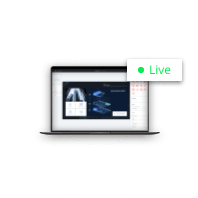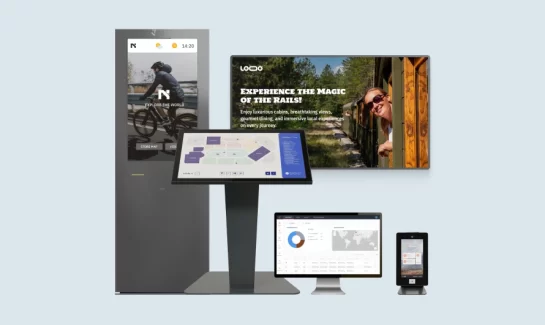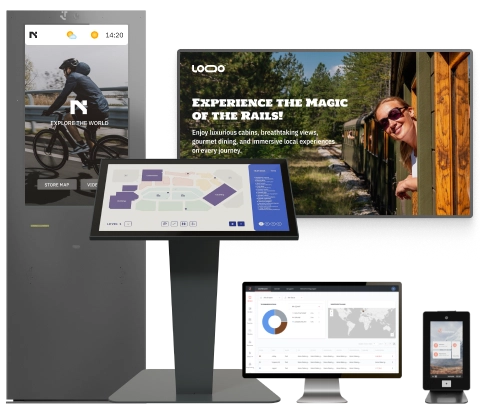TL;DR: Paper sign‑ins and radio calls create bottlenecks at the gatehouse and lobby. A modern digital check-in system speeds up arrivals, enforces factory visitor safety protocols, and provides security with a live roster of who is on site, where they are, and for how long. With self-service visitor kiosks and tight access control integration, industrial teams reduce dwell time, minimize risk, and stay audit‑ready.
(Prefer videos? Watch a brief summary of this article below.)
The Industrial Check-In Problem (and Why It Matters)
Industrial sites face unique safety requirements, visitor types, and throughput spikes that manual check-ins cannot handle at scale.
Safety and compliance realities
Industrial facilities juggle a unique mix of visitors, including drivers, contractors, inspectors, and VIP guests. Each may require PPE confirmations, toolbox talks, escorted access, and documented consent. A scalable approach to industrial visitor management ensures site rules are seen, acknowledged, and time‑stamped before anyone steps onto the floor.
Operational friction with manual processes
Paper logs, radios, and ad‑hoc spreadsheets slow arrivals, especially at shift change and peak delivery windows. Language barriers add confusion; hosts aren’t notified in time; badges are handwritten and inconsistent. The result is queues at the gate, idle dock doors, and frustrated visitors.
Business impact
Small delays compound into missed dock appointments, maintenance overruns, and unplanned downtime. Conversely, efficient flows shave minutes off every arrival, protecting production schedules and improving onsite security for warehouses and factories alike.
What Digital Check-In Looks Like Today
Digital visitor check-in at factories replaces paper and walkie-talkies with guided workflows and real-time visibility. Here is how modern facilities leverage it.
Core benefits
- Speed and accuracy: Data is captured once and reused when necessary.
- Consistency: Standardized workflows for every visitor type.
- Visibility: Real‑time headcount, locations, and dwell times.
Self-service options
Deploy self-service visitor kiosks at the gatehouse, lobby, or shipping office. Add mobile pre‑registration so visitors arrive with a QR code. A guest registration kiosk can print badges, trigger host alerts, and display visitor instructions (at docks, doors, or meeting rooms).
Real-time visibility and access control
Live dashboards display who has checked in, who has completed safety training, and which zones each guest has permissions to enter. With access control integration, temporary credentials are automatically issued and revoked at sign‑out or visit end.
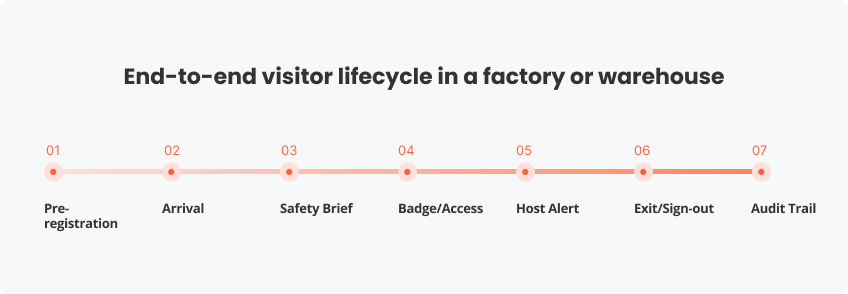
Must‑Have Capabilities for Industrial Environments
To handle peak volume and strict safety rules, look for capabilities that reduce friction while enforcing compliance.
ID capture and visitor badge printing
Scan government IDs or driver’s licenses (where permitted), take a photo, and support on‑demand visitor badge printing, including driver passes with dock or zone permissions.
Pre-registration and invitation links
Send invitations with arrival details, parking maps, and QR codes for automated visitor registration. Pre-registration slashes lobby time and improves data accuracy.
Contactless, multilingual, and accessible
Offer a touchless check-in system via QR code or NFC tap, featuring large fonts, audio prompts, and multi-language flows to support diverse crews.
Safety workflows (briefings, attestations, NDAs)
Display short safety videos or pictogram guides, collect digital signatures, confirm PPE, and log toolbox talk acknowledgments — your visitor screening at industrial sites becomes consistent and auditable.
Host alerts and notifications
Automatically notify hosts via email or Microsoft Teams the moment a visitor arrives or a driver clears the gate.
Offline mode and failover
Warehouses can be connectivity-challenged. Select devices with LTE backup, local caching, and UPS power to make arrivals continue even if the network goes down.
Emergency preparedness and mustering
When alarms sound, seconds matter. Your check-in system should become your mustering system instantly.
A modern system provides real-time muster lists, badge scanning at rally points, tablet-based roll calls, and an “all-clear” record. Post-event reports help refine evacuation plans and shorten future response times.
Modernize arrivals with rugged kiosks, pre-registration, badge printing, and real-time visibility — built for factories and warehouses.
Security and System Integration Architecture
The right architecture connects check-in to doors, gates, and business systems, enabling people to move quickly and only where they are authorized to do so.
Zone-based or timed permissions
Issue temporary, purpose-based credentials (for example, “Dock 4 only,” “Maintenance Bay, 2 hours”). When the visit ends, access ends.
Gates, turnstiles, RFID, and license plate recognition
Sync kiosks with turnstiles, door controllers, and yard systems to efficiently move visitors. RFID or LPR (license plate recognition) can accelerate driver flow and reduce gatehouse workload.
System syncs that matter
- Access control integration (ACS): Automatically create or expire visitor credentials.
- WMS and ERP: Pull scheduled dock slots and purchase orders to validate arrivals.
- EHS and LMS: Assign and record mandatory safety modules.
- IdP, SSO, and SCIM: Keep host directories up-to-date and enforce role-based permissions.
Digital records and audit trails
Generate digital visitor logs with time stamps, consent records, and badge activity. Configure retention to meet policy and export in seconds for incident reviews or audits.
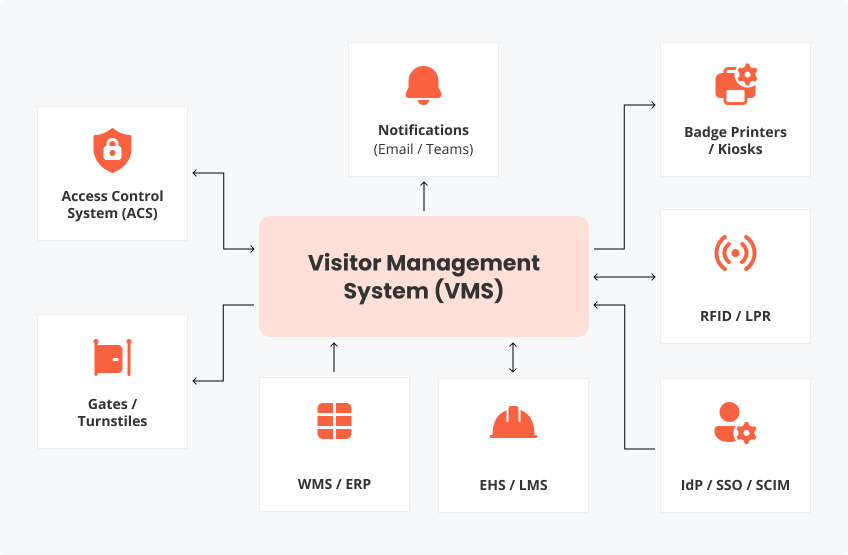
Industrial Use Cases (Persona-Based)
Different visitors have different goals and risks. Tailor workflows by persona to keep traffic flowing and compliance tight.
Drivers and carriers (third-party logistics or last mile)
Gatehouse kiosk pre-screens drivers, verifies load or purchase order, prints a yard pass, and shares dock door instructions. Dispatch and security see dwell time trends through warehouse access tracking.
Contractors and maintenance crews
A guided contractor check-in process ensures permits-to-work, safety attestations, and timed access to service areas. Hosts are automatically alerted; badges expire at the end of the shift.
Auditors and inspectors
Pre-registration captures scope and required documents. Upon arrival, visitors receive escorted or restricted access and sign NDAs digitally for a clean audit trail.
VIP guests and customer tours
Branded invitations, fast sign-in, and escorted routes make a strong first impression without sacrificing safety.
Implementation Playbook
A smooth rollout blends the right hardware, clear signage, simple training, and strong security fundamentals.
1. Hardware selection for harsh environments
Choose industrial kiosks with ruggedized enclosures, IP-rated components, sunlight-readable and glove-friendly screens, and thermal printers. Consider camera modules and barcode or RFID readers that are tailored to your site.
2. Site design and wayfinding
Place kiosks where visitors actually arrive, such as gatehouse lanes, shipping and receiving entrances, and main lobbies. Use clear signage, queue guides, and multilingual prompts to facilitate the flow.
3. Training and change management
Align security, reception, yard marshals, and maintenance coordinators on new workflows. Provide quick reference guides and brief train-the-trainer sessions to accelerate adoption.
4. Network and data security
Segment devices on VLANs, enforce TLS encryption, apply role-based access, and enable audit logging. Also, configure data minimization and retention policies to your compliance requirements.
5. Measuring success (KPIs and ROI)
If you cannot measure it, you cannot improve it. Track a few simple metrics to prove impact and guide iteration: average check-in time, pre-registration rate, dock door utilization, first-time pass rate, SLA for host response, evacuation roll-call time, and audit export time.
A simple ROI model: minutes saved per visit × average fully loaded wage × monthly visitor volume — plus avoided downtime from faster maintenance access and fewer gate delays.
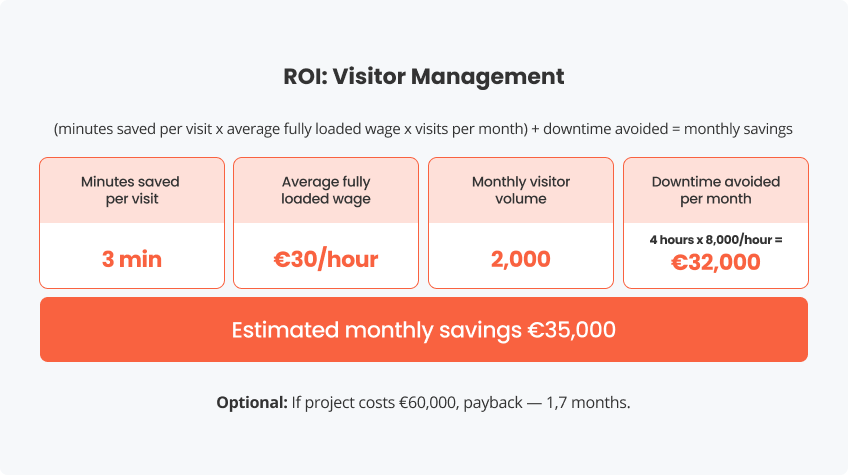
Conclusion
Industrial visitor flows do not have to be a bottleneck. With a purpose-built digital check-in system, you can standardize safety, accelerate arrivals, and give security real-time control — all while improving the visitor experience.
friendlyway’s approach pairs rugged hardware with intuitive software to simplify operations across plants and distribution centers. Whether you are upgrading a single gatehouse or rolling out multi-site industrial visitor management, the path to measurable impact is straightforward: digitize, integrate, and iterate.
FAQ
Quick answers to the most common questions we hear from plant, security, and IT leaders.
Yes. Industrial-grade kiosks feature rugged enclosures, high-brightness displays, glove-friendly touch, and components rated for dust and temperature swings. Place them at the gatehouse, shipping office, and lobby to balance throughput and protection.
It enforces visitor safety protocols through mandatory briefings, PPE checks, and digital acknowledgments before granting access. Combined with access control integration, permissions are limited to the right zones and automatically revoked at sign-out.
Multilingual interfaces, large-font modes, and audio prompts help every visitor complete the process confidently. A touchless check-in system (that uses QR or NFC) is ideal when hands are full.
Yes. Integrations with WMS and ERP share shipment or dock appointment data to validate arrivals and reduce manual entry. This also enhances warehouse access tracking and improves yard planning.
Visitors “start” on check-in and “end” on badge return, QR sign-out, or a timed auto-expire. The system updates digital visitor logs, disables temporary credentials, and maintains on-site security for warehouses.
